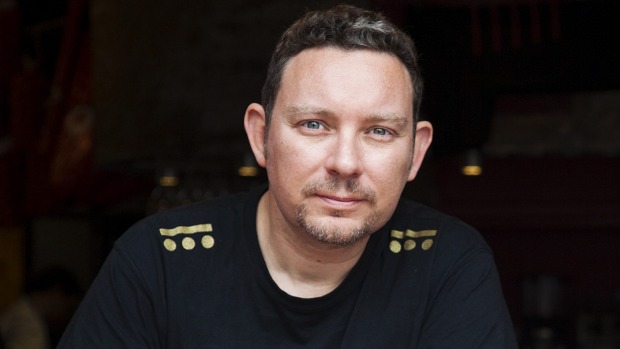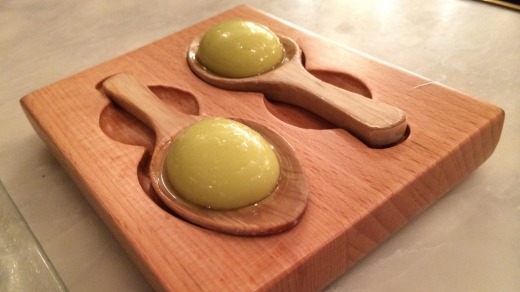
They're not olives. They look like olives, and they're listed on the menu as olives, but anyone in the know here would tell you that they're not actually olives.
They're still going to taste good though.
I pick one of the wooden spoons off the table, balancing the green, wobbly not-olive at its centre, and regard its shiny perfection for a few moments before tipping it into my mouth. Boom! It's an explosion of tastiness, a liquid grenade of flavour, all olive brininess mixed with the salt of anchovies and the heat of guindilla chillies.

It's a little blob of unexpected perfection. But then, that's the idea. Everything here at Bodega 1900 is supposed to be a surprise. It's designed to be a pleasant shock. That the restaurant is even here is something of a revelation.
This little vermouth bar on a quiet street in Barcelona's Poble Sec district has a royal pedigree. You wouldn't know it by the modest signage, but it's owned and run by Albert Adria, former chef at the world's best restaurant, El Bulli, and brother of that establishment's famous figurehead, Ferran Adria.
In Spanish food circles, and indeed throughout the world, the Adria brothers are kind of a big deal. For years the two of them guided El Bulli to the very top rung of gastronomy, before, to the surprise and disappointment of the foodie world, promptly closing the restaurant to move on to other things.
Those other things have now arrived, and they're in Poble Sec. This is what the world's best chefs did next: build a foodie empire in a once rough and still mostly unremarkable part of Barcelona.
Poble Sec is now studded with multiple Adria restaurants serving cuisine that ranges from affordable and approachable to expensive and innovative. The pair have taken over the entire "barri", or suburb, to the point that it's now referred to as "Barri Adria". And it's good. So good.
I'm eating today at Bodega 1900, one of Albert Adria's creations modelled on a traditional old Spanish vermouth bar. They make their own vermouth in-house here, served by waiters in shirtsleeves and bow-ties and accompanied by snack food ranging from the famous "not-olives" to marinated, house-tinned sardines, knots of thin, cured sausages served with custom-made knives, and some of the finest jamon iberico you'll ever lay eyes on.
It's a simple, casual, and very approachable version of Adria cuisine that serves as a great appetiser for the Barri Adria experience.
What's next? You could go to Tickets, Ferran Adria's flagship tapas bar, just a few doors down the road. But Tickets is booked solid for three months in advance. The food there is as exquisite and innovative as it was at El Bulli, only at a fraction of the price, which explains the popularity. Good luck getting in.
You could also try Nino Viejo, the Adrias' taco bar, or Hoja Santa, specialising in upmarket Mexican cuisine, or pretty soon Enigma, the brothers' latest cocktail bar project, set to open in 2016. The pair have even partnered with another set of famous Spanish foodie brothers – Juan Carlos, Borja and Pedro Iglesias – to have a hand in the traditional tapas bars El Canota and Rias de Galicia. And all of these restaurants are in Poble Sec, in a two- or three-block radius.
They all sound amazing, but today I'm going with one of Ferran Adria's passion projects, a Peruvian-Japanese fusion restaurant called Pakta. It seems a strange combination – a Spanish master chef tackling a blend of Peruvian and Japanese cuisines. But this "Nikkei" style is one Adria has been championing for some time, and I'm keen to see what the fuss is about.
Pakta is a much more formal affair than Bodega 1900, an intimate 32-seat diner decorated to reflect its menu, with bottles of sake and Japanese artworks placed next to Peruvian tapestries and traditional ekeko figurines. The menu is degustation-style only – diners are given the choice between the 19-dish Fujiyama menu and the colossal 25-dish Machu Picchu menu.
I opt for the modest 19-course meal, a decision that had to be made days ago, via email, to allow the kitchen to prepare the exact amount of food that would be required for the night. I'm seated at the sushi bar and handed a pisco sour. I watch as a team of gastronomic surgeons slices fish and moulds rice and sears oysters, before my first plate of six small dishes – from sashimi to ceviche – arrives and I'm given a very precise lesson by the waitress in how to eat them all.
Pakta is good, I soon realise. Ridiculously, surprisingly and consummately good. It's a little Japanese, and a little Peruvian, and entirely Adria. Just as this whole district is. Delicious.
This is what the world's best chefs did next. And it was worth the wait.
TRIP NOTES
MORE INFORMATION
elbarriadria.com
GETTING THERE
Qantas flies daily from Sydney to Barcelona, via Dubai. See qantas.com.
EATING THERE
You'll need to book ahead to eat at any of the Adrias' restaurants, though some, like Bodega 1900, are easier to get into than the extremely popular Tickets. For all reservations and address details, go to the website listed above.
The writer travelled at his own expense.